TWO-STROKES BONANZA! KX112, YZ250 & KX315 TWO-STROKE CHRONICLES
By Josh Mosiman
It’s been my experience that most riders go through phases. You learn how to ride on a four-stroke (I learned on an XR50; someone starting later might begin on an XR100 or CRF125F), and then you advance to a two-stroke. I went to a KTM 50SX Senior, but someone starting a few years later might transfer to a KTM 65SX, Kawasaki KX85 or Yamaha YZ125. Then, with more time and experience, you’re ready to jump to the 250 four-stroke and sign up for some real races in the “big bike” classes.
This four-stroke period often lasts for years and maybe even decades for some, but eventually, the heart starts yearning for the sound of an FMF shorty, the smell of two-stroke fumes and the charged feel of a two-stroke engine. This realization comes sooner or later, and it’s usually a mental battle when it arrives. To make the big step back to a two-stroke, you gotta answer these questions: Do you sell the four-stroke to be able to spend more money on your two-stroke project? Do you keep the four-stroke because it’s much easier to ride and you might want to line up for a few races next year? Do you get a 125, a 250 or a 300? New or used?
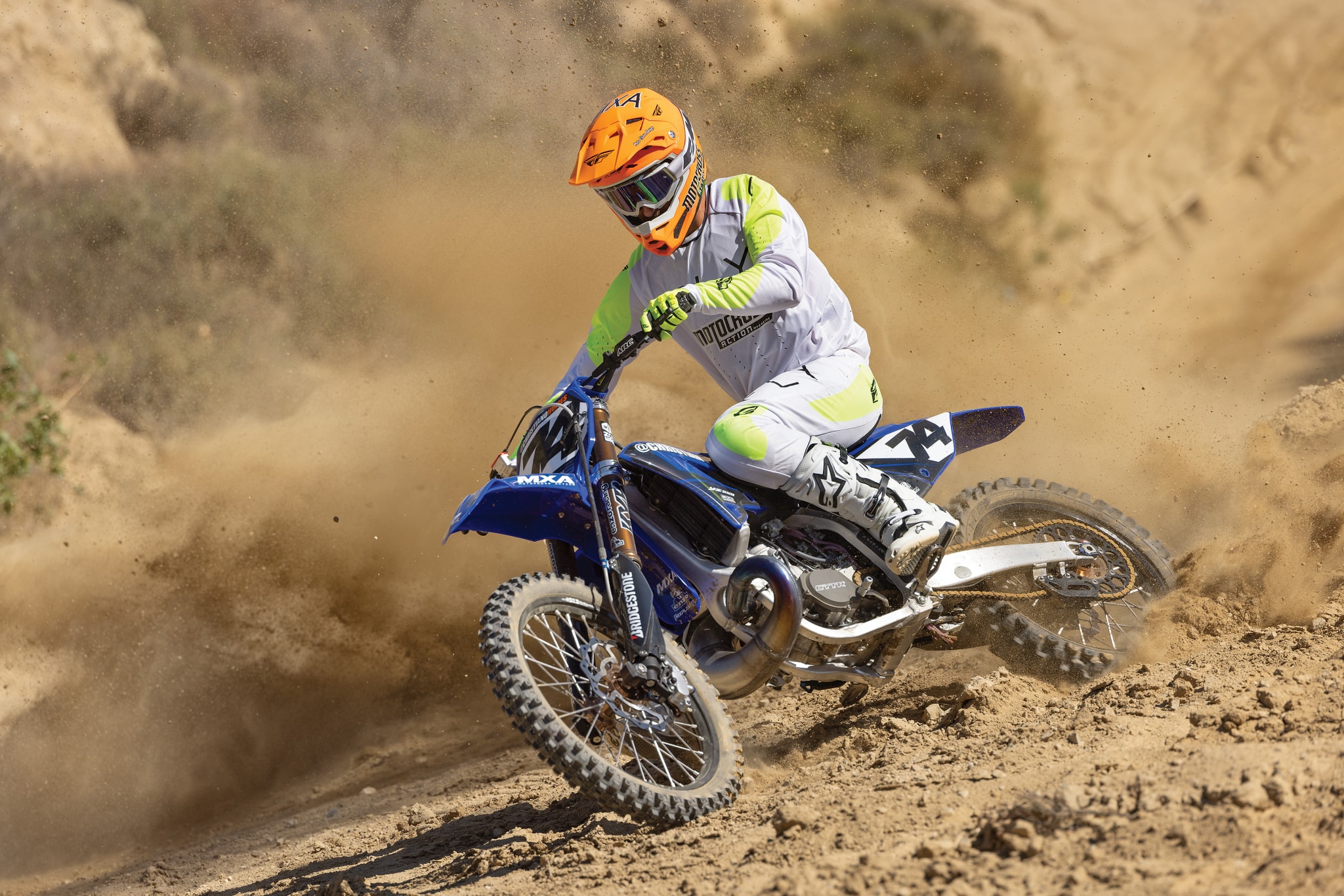 Steve Christiano’s YZ250.
Steve Christiano’s YZ250.
Your options will vary based on the size of your wallet, but no matter where you are in your motocross riding journey, the desire for castor oil and a carburetor will come back to you. Just ask Ryan Villopoto or Jeremy McGrath.
Over the last few months, I’ve had the opportunity to ride some unique two-strokes, and these three deserve some special recognition. Landen Gordon is at a very exciting yet nerve-wracking point in his motocross journey. He’s a Team Green Amateur who’s on track to be the next big thing. With sponsors like Kawasaki, Pro Circuit, Dunlop and Alpinestars behind him, Landen has access to all the tools needed to succeed. He’s at the stage where he just traded in his two-stroke KX85 and KX112 Superminis for a fuel-injected, electric-start Kawasaki KX250 four-stroke. He’s already tried his hand in a few Supercross Futures rounds on the 250 this year. We decided to take a step back to test Landen’s 2023 Loretta Lynn Championship-winning Kawasaki KX112 Supermini.
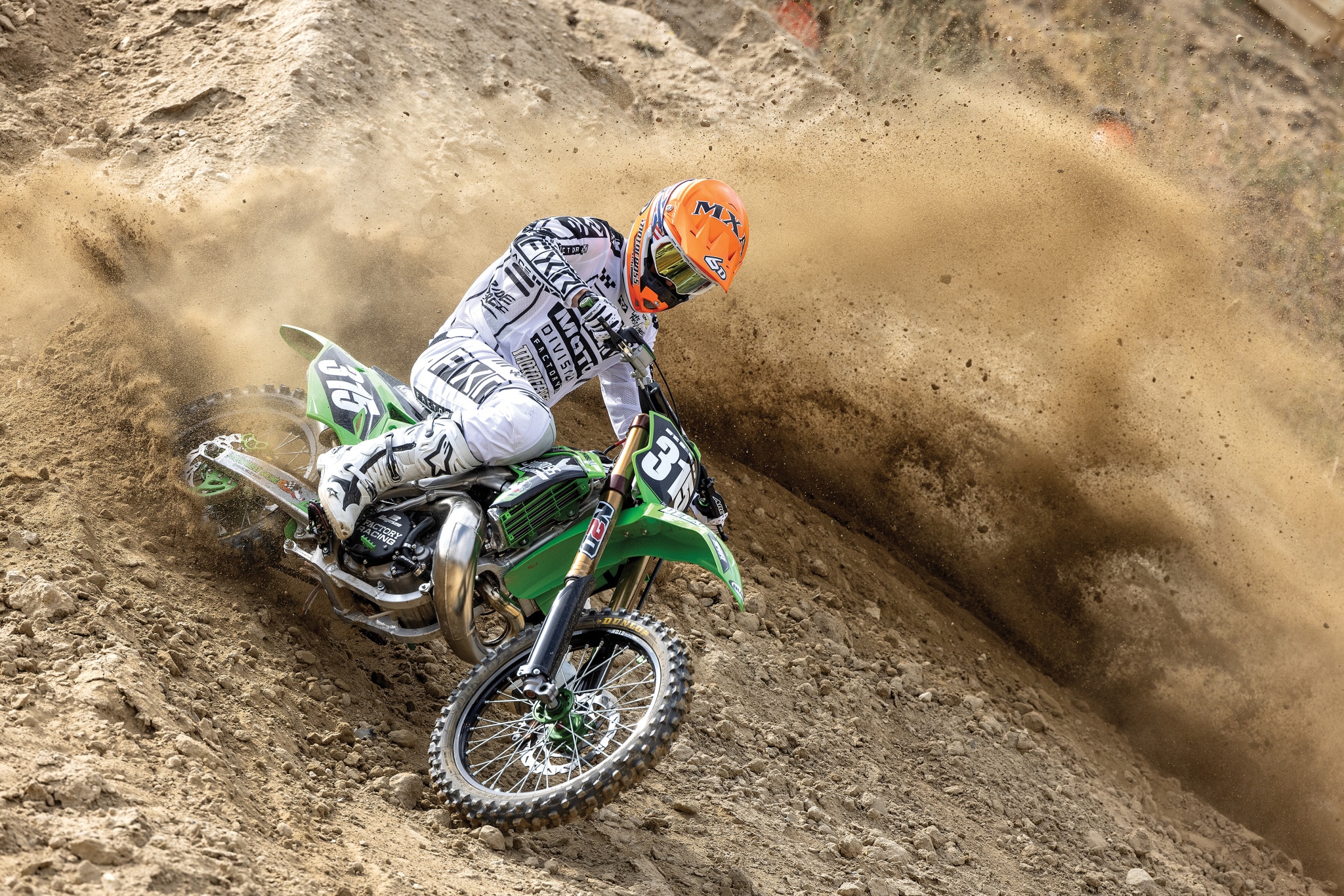 Robert Reed’s KX315.
Robert Reed’s KX315.

Then, we tested Steve Christiano’s YZ250 and Robert Reed’s KX315. Being well-seasoned Vet riders, Steve and Robert are much further along than Landen, but their stories are still unique. Steve races regularly on a KTM 450SXF, and he’s had a KTM 250SX two-stroke for a while, but he didn’t want to make the jump to the new fuel-injected ’23–’24 KTM two-strokes, so he went blue. The YZ250 is his play bike, while the KTM 450SXF is still his race bike. Robert Reed, on the other hand, went all in on his two-stroke adventure. His Kawasaki KX315 was a labor of love. He spent years on this project, gathering parts, and finding the right suspension, engine and chassis tuners before assembling it all.
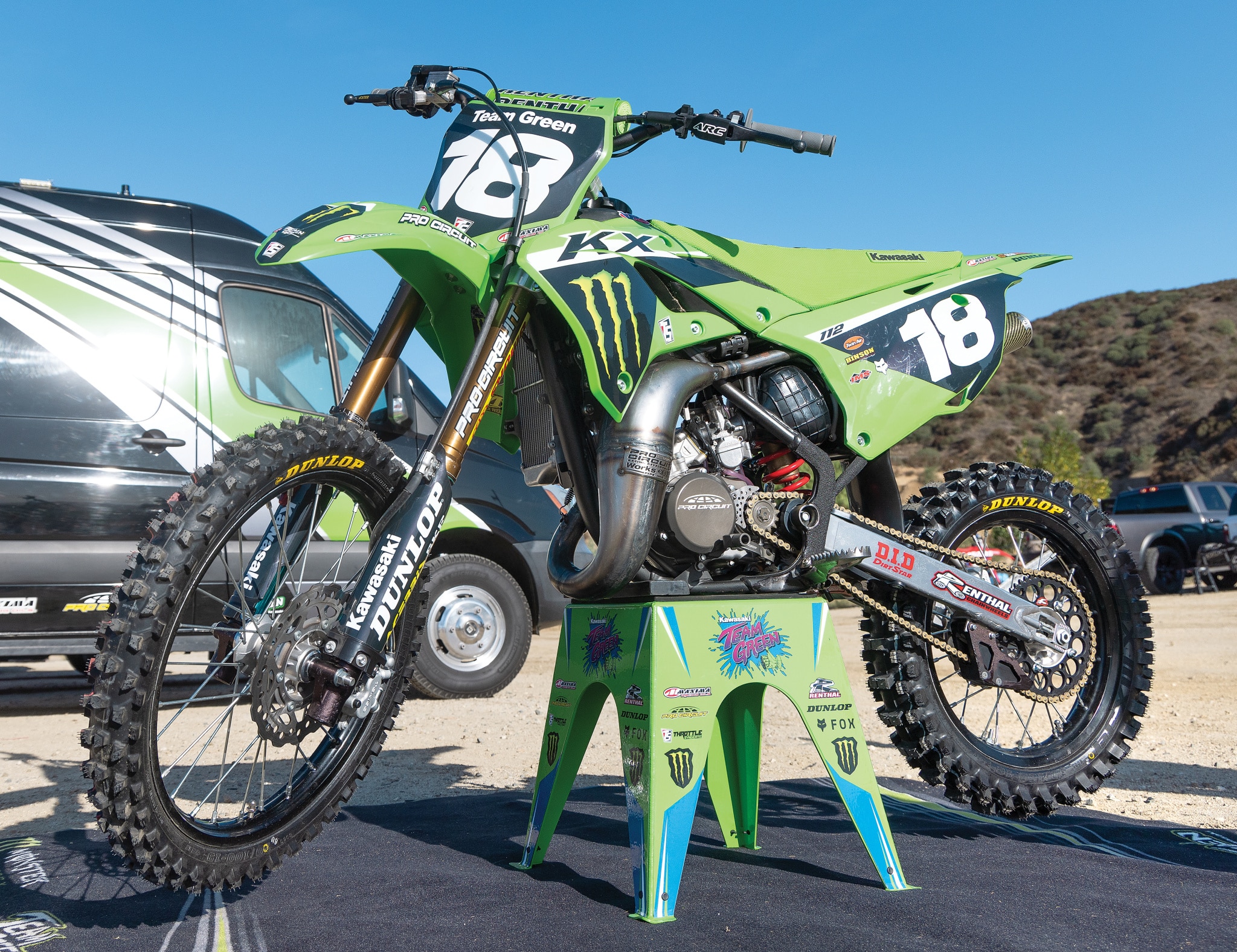 Landen Gordon won the Supermini 2 class last year at Loretta’s on this Pro Circuit KX112.
Landen Gordon won the Supermini 2 class last year at Loretta’s on this Pro Circuit KX112.
LANDEN GORDON’S FACTORY TEAM GREEN KAWASAKI KX112 SUPERMINI
Landen Gordon’s KX112 Supermini is a masterpiece and a history lesson all in one. Because the KX85 platform hasn’t changed a whole lot over the years, this bike still looks and feels like Ricky Carmichael’s and James Stewart’s KX80s of old. Ryan Villopoto even spent time on this platform, as well as Adam Cianciarulo, Austin Forkner, Ryder DiFrancesco and more top Pros.
Kawasaki is an underdog in the mini-bike ranks, as Kawasakis are wildly outnumbered by KTM/Husky/GasGas machines at the Amateur Nationals, but you wouldn’t know that if you only looked at the winners of each class. Kawasaki has a strong recruiting department for its Team Green program and offers great support to promising young riders.
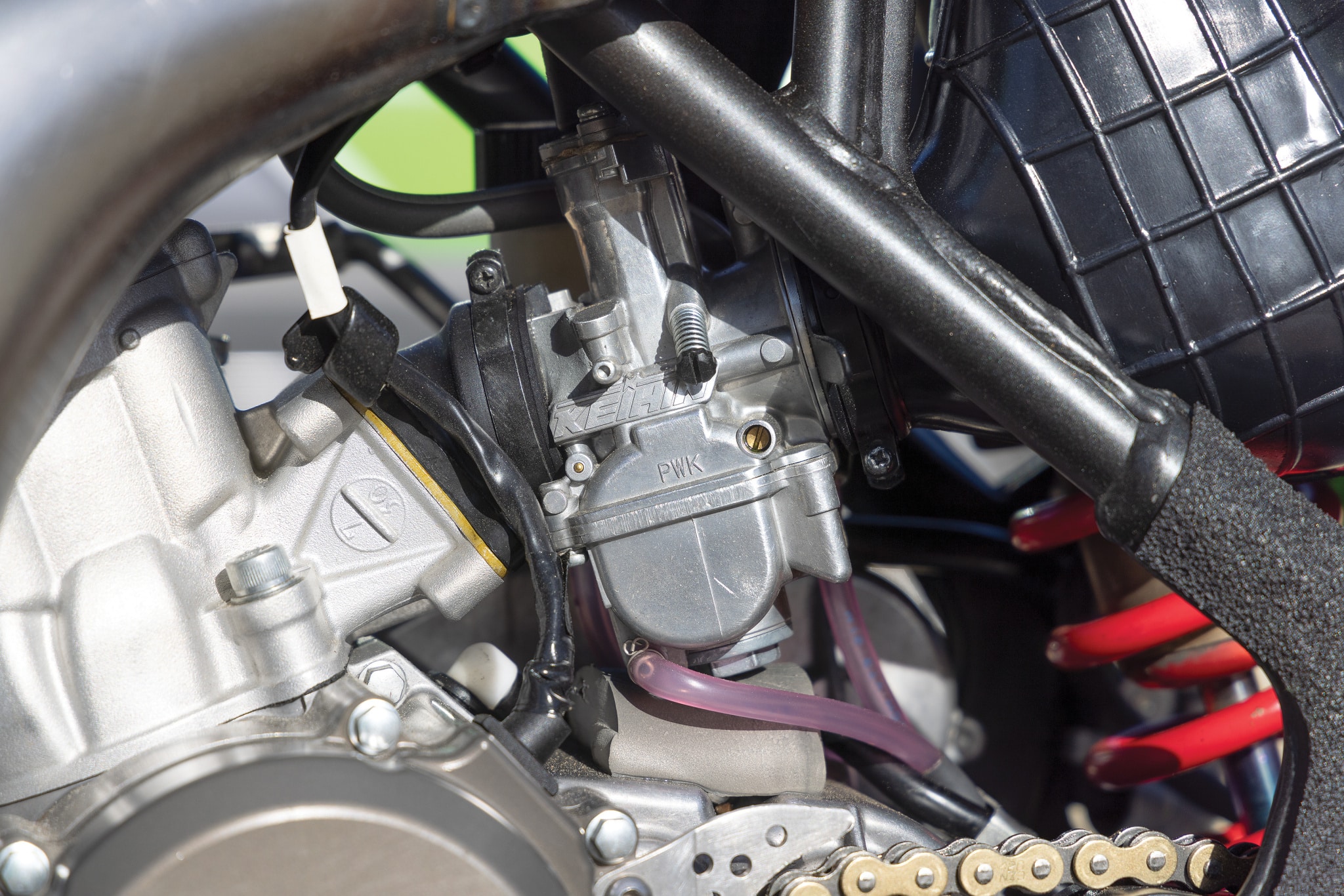 Notice the crossbar pad foam under the carb? That’s factory.
Notice the crossbar pad foam under the carb? That’s factory.
The KX112 Supermini platform has been refined over the last couple years by Mitch Payton. Pro Circuit dynos multiple engines to see which cylinder produces the most power, then the winner gets saved for Loretta’s and the others get used for miscellaneous Amateur races and practices. Intervals for a top-end on this full-race KX112 are 10 hours, and Landen can go 20 hours on a crank. They also install Showa A-Kit suspension for Landen. The A-Kit shock has a low-speed comp valve (stock doesn’t). The stock Kawasaki KX85 shock has a 36mm body with a 12.5mm shock shaft, and the stock forks are 36mm in diameter. The Showa A-Kit setup has a 40mm shock body, 14mm shock shaft and 37mm forks, which require Pro Circuit triple clamps. Plus, Pro Circuit matches the factory race team look with a turquoise coating on the lower fork legs and Kashima uppers. Anyone can buy this Showa A-Kit suspension setup for $5500 through Pro Circuit.
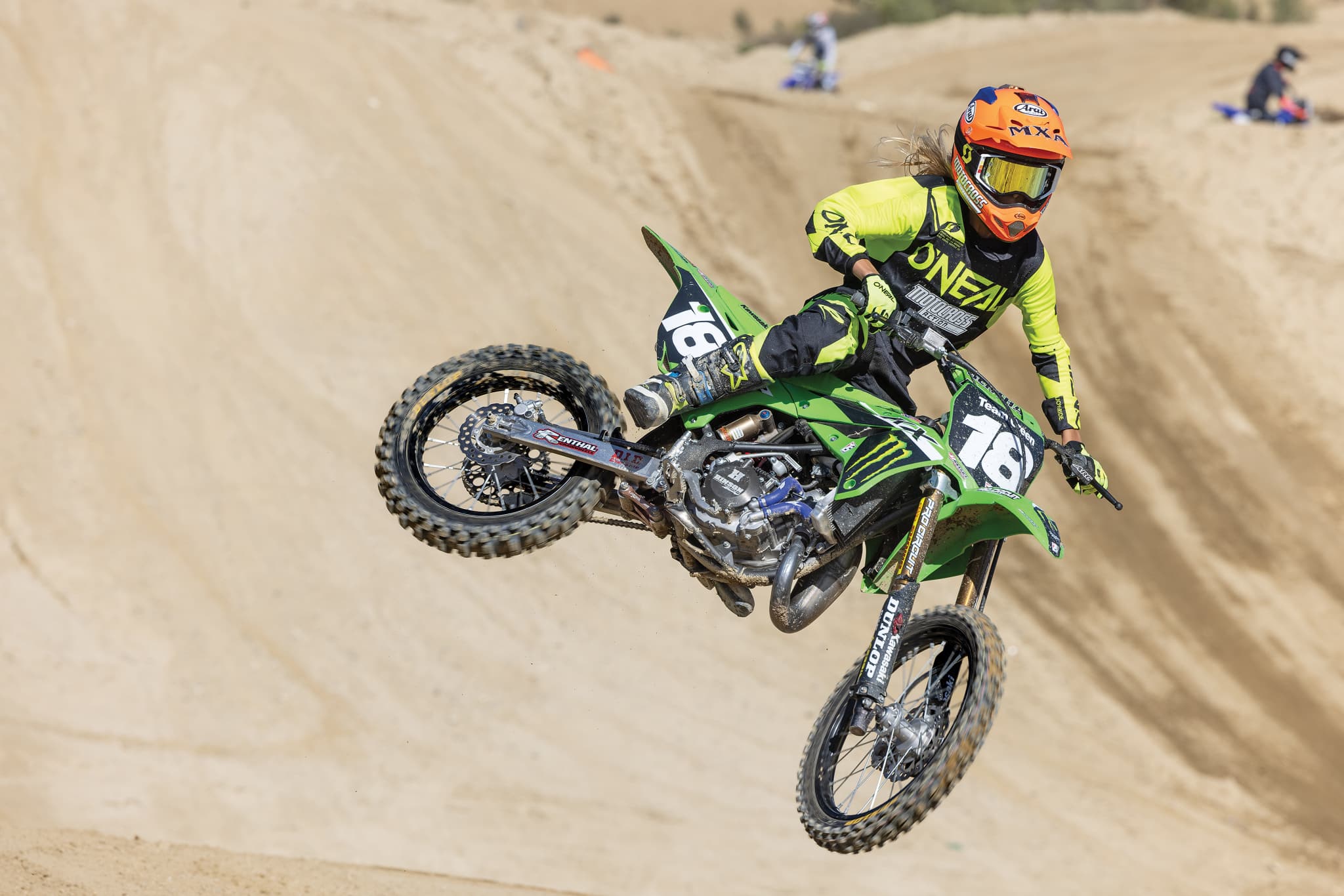 Landen Gordon’s KX112 Supermini.
Landen Gordon’s KX112 Supermini.
The KX112 also uses a Pro Circuit link arm/knuckle and Raptor titanium big bike pegs that are cut down to fit the mini. Landen uses stock wheels with Renthal sprockets at a 14/51 ratio, a D.I.D 420 gold chain, and Dunlop MX34 tires. Of course, a Pro Circuit pipe with Ti-2 shorty Kevlar silencer was selected, along with Works Connection’s Pro Launch holeshot device, tall seat foam from Guts Racing, a Throttle Syndicate seat cover, ARC levers, and Renthal grips and handlebars in the 809 7/8-inch mini bar bend. Landen’s KX112 also has a Pro Circuit throttle tube, Pro Circuit radiator hoses, a stock carburetor with Pro Circuit tuning, and a bar-pad foam underneath the carb for added strength and stability.
Everything inside the engine is available to the public through Pro Circuit. Just ask for the KX112 race spec. Landen ran stock reeds with a Hinson clutch and clutch basket. His mechanic, Mario Testa, used heat shrink on all the lines at the fittings to keep water out. Also, he ran an oversized radiator, and Pro Circuit provided the front brake-line holder, shift lever and ignition cover. Mario polished the swingarm and engine cases and vapor-blasted the cylinder. And last, he used a Twin Air filter, VP fuel in a blend of C12 cut with MRX02 with Castor 927 oil from Maxima, and a Works Connection hour meter.
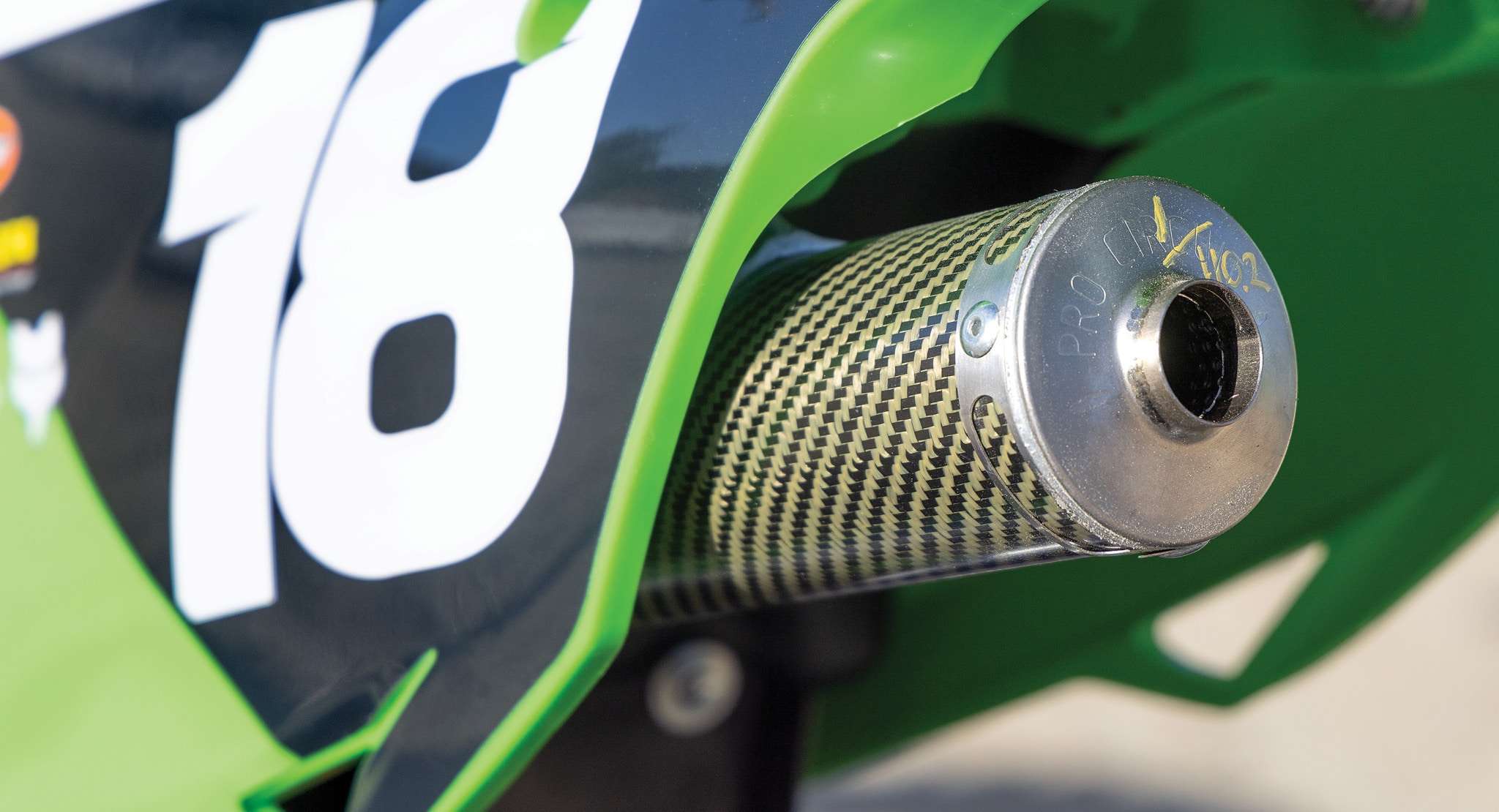 The Pro Circuit Kevlar silencer.
The Pro Circuit Kevlar silencer.
On the track, the Kawasaki KX112 was incredible. It never stopped pulling. The power-to-weight ratio of this bike was insane. It is lighter than a 125, and it has smaller wheels, making it run faster than most of the 125 two-strokes I’ve ridden. I grew up racing against Adam Cianciarulo, and his bike wasn’t too different from this one. We had Mowgli Roe test the bike for us and compare it to his KTM 105SX. He loved how long the KX power pulled on top. He thought his KTM 105SX had more bottom, but the KX112 pulled much further, which makes sense because it’s built to run wide open with a skilled rider at the helm.
Of course, I had to jump on it as well. Even though I’m 6 feet tall and 170 pounds, Landen’s bike had no issues pulling me around the National track at Glen Helen. Riding the Supermini wide open brought back some memories of being passed by Adam Cianciarulo virtually every Amateur race as I was growing up. Adam’s bikes always ran perfectly, and this one did, too.
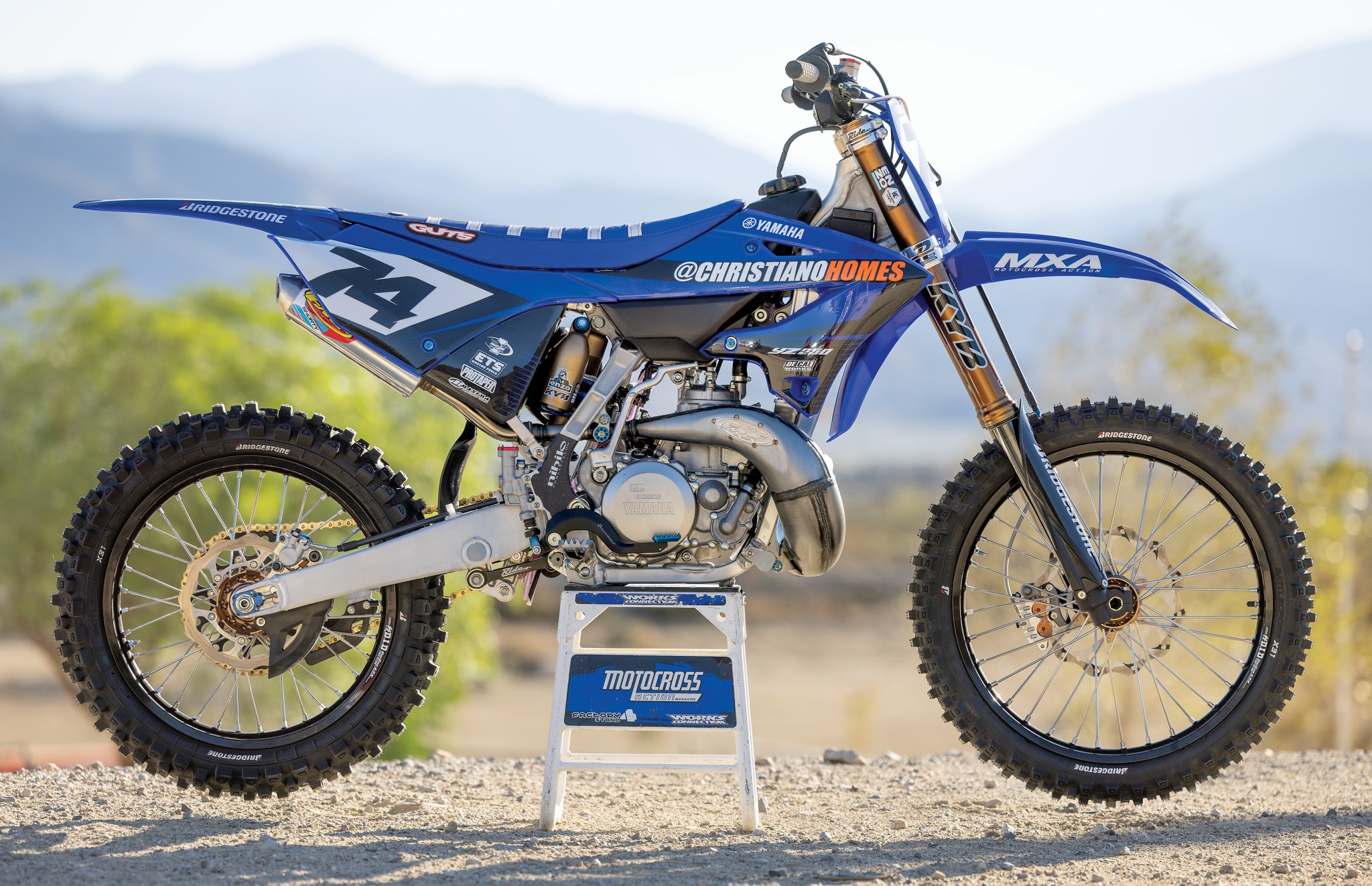 Ride Engineering and Twisted Development maximized the fun factor of the YZ250.
Ride Engineering and Twisted Development maximized the fun factor of the YZ250.
STEVE CHRISTIANO’S RIDE ENGINEERING 2023 YAMAHA YZ250
The Yamaha YZ250 is one of the most straightforward motocross bikes on the market. It received a new subframe and bodywork in 2022, but hasn’t seen any drastic changes since 2006. It’s such a good platform that our test riders have a blast on it in stock form, but we’ve also built countless YZ250 project bikes with the endless number of parts that are available for this bike. Every long-time engine or suspension tuner has a spec for this bike that’ll make it run perfectly for you.
For this build, Steve Christiano dropped the bike off to Adrian at Ride Engineering. Steve is a KTM guy, and he knew Adrian could point him in the right direction with his new blue steed. Starting with Ride Engineering parts, Steve used the current-generation, 23.5mm-offset, rubber-mounted split triple clamps. The stock offset is 25mm, and the 23.5mm setting shortens the wheelbase to make the bike turn a little easier. Those Ride clamps come with anti-twist bar mounts, soft poly cones, and all the necessary hardware (net weight savings of about 7 ounces over stock).
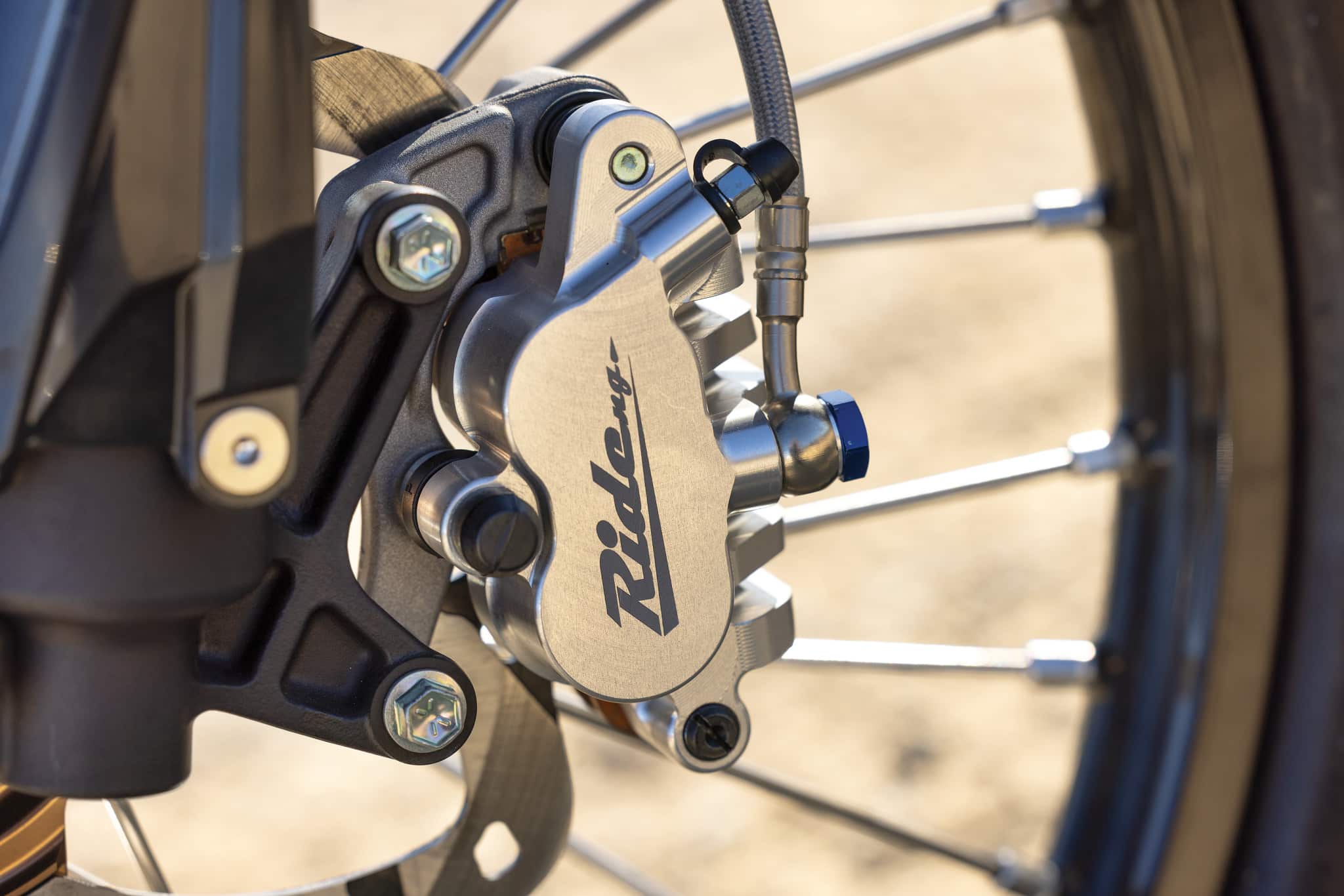 Ride Engineering’s front brake caliper is stiffer and stronger than stock.
Ride Engineering’s front brake caliper is stiffer and stronger than stock.
To improve braking power, they used front and rear braided-steel lines, billet brake-line mounts, and the addition of Ride Engineering’s billet brake caliper that uses larger pistons mated to a Honda CRF450 front master cylinder. This made for a powerful but soft/progressive front brake feel. It was mated to a Ride Engineering, 270mm, non-floating wave rotor.
Steve also used Ride Engineering’s eccentric link arm. In the performance setting, it’s 1mm longer than stock to help keep the rear end planted and hooked up under the explosive two-stroke power. Trail riders or shorter riders can flip the insert to lowering mode, which is 3mm longer than stock, providing a 1-inch drop in ride height to help with technical trails and hill-climbs where reaching the ground with your feet is a huge advantage.
Enzo Racing built the suspension. They re-valved and re-sprung it for Steve (a 220-pound Vet rider) with Kashima and DLC coatings on the forks to make it look and feel factory. Steve used the stock gearing (13×48) with a Renthal sprocket and gold D.I.D 520 chain. The black D.I.D rims were mated to brown Haan hubs with X31 Bridgestone tires front and rear.
Twisted Development did their YZ250 porting and carb mods using ETS Race fuel (US18 K2) with Maxima premix. A YZ250 wouldn’t be complete without an FMF pipe and silencer, and Steve used ProTaper’s SX-bend Evo handlebars, a Guts seat cover, and Raptor titanium footpegs to cover the rider triangle contact points. Decal Works provided the custom graphics pre-applied to aftermarket plastic, ensuring Steve and Adrian didn’t have to worry about bubbles in the shrouds. They also used a GYTR billet ignition cover and plastic chain guide.
>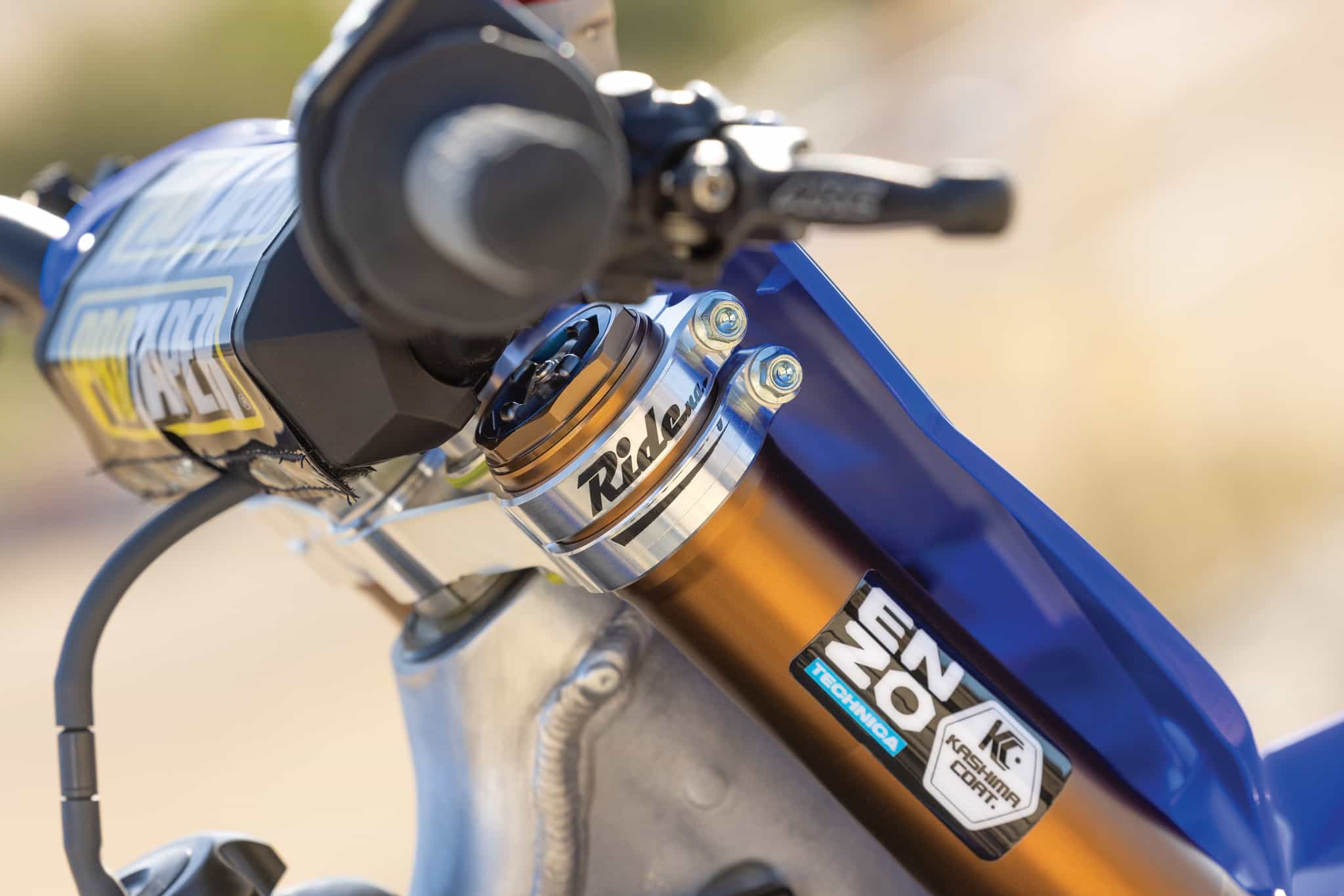 The Ride Engineering clamps shortened the wheelbase slightly and made it more nimble.
The Ride Engineering clamps shortened the wheelbase slightly and made it more nimble.
On the track, Steve Christiano’s YZ250 rode like a dream. Yes, the suspension was too stiff for me, but I wasn’t worried about it because I was having so much fun with the YZ250 engine. This was by far the cleanest-running YZ250 I’ve ever ridden. It had a snappy and extremely fun power profile that put a grin on my face. I should mention that Steve used a G2 Ergonomics quick-turn throttle tube that was the cherry on top of this build, building off the snappy goodness of the Twisted-tuned YZ250 engine.
The Ride Engineering lowering link arm didn’t make a world of a difference for me, but it did help bring the rear end down slightly, which boosted my confidence. I never thought to change the offset on the YZ250 before, but the 23.5mm offset clamps were a pleasant surprise. This thing was light and nimble, making the fun factor extremely high.
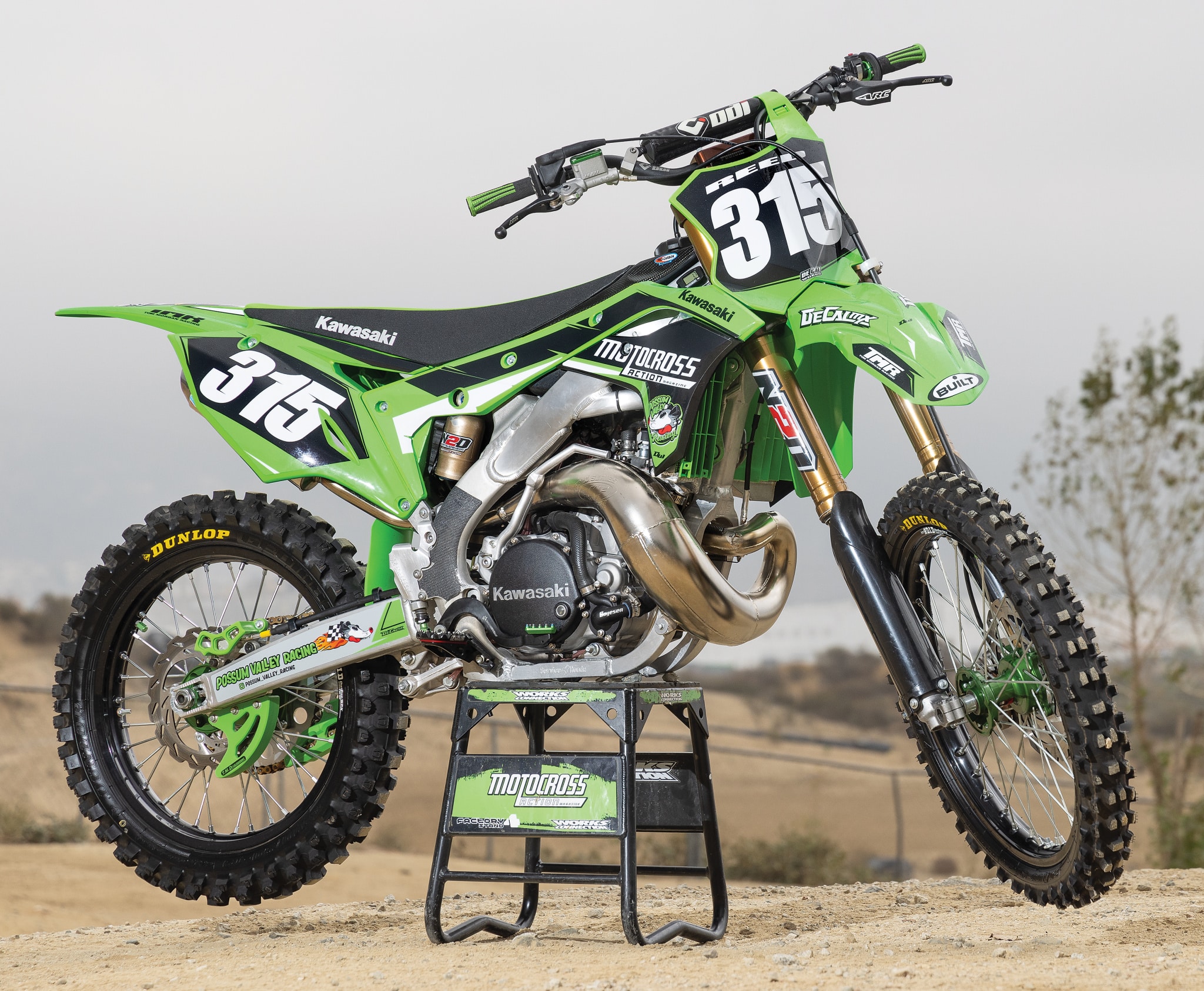 This KX315 engine was built by Tom Morgan and rode like a more enjoyable 500 two-stroke.
This KX315 engine was built by Tom Morgan and rode like a more enjoyable 500 two-stroke.
ROBERT REED’S POSSUM VALLEY RACING KAWASAKI KX315
Robert Reed grew up riding motocross, but his motorcycle journey took a long pause until 2007 when his friend’s CR125 build reminded him of his love for two-strokes, inspiring him to teach his son about the world of dirt bikes. Robert is the kind of guy who loves to find good deals online and give old two-stroke engines a second chance at life…in a new chassis! For this build, Robert took a 2018 Kawasaki KX250F chassis and had AJ Waggoner of Built 500 modify the frame to accept a 1996 KX250 two-stroke engine. The engine was bored and stroked to 315cc with a ported cylinder and modified head. Tom Morgan built the engine, but when Robert originally went to TMR, he wanted the 327cc upgrade; however, Tom swayed him to go for a 315cc. Parts are more readily available for the KX315 build, as he can use a stock KX250 rod farther out on the webs of the crank to get the longer stroke.
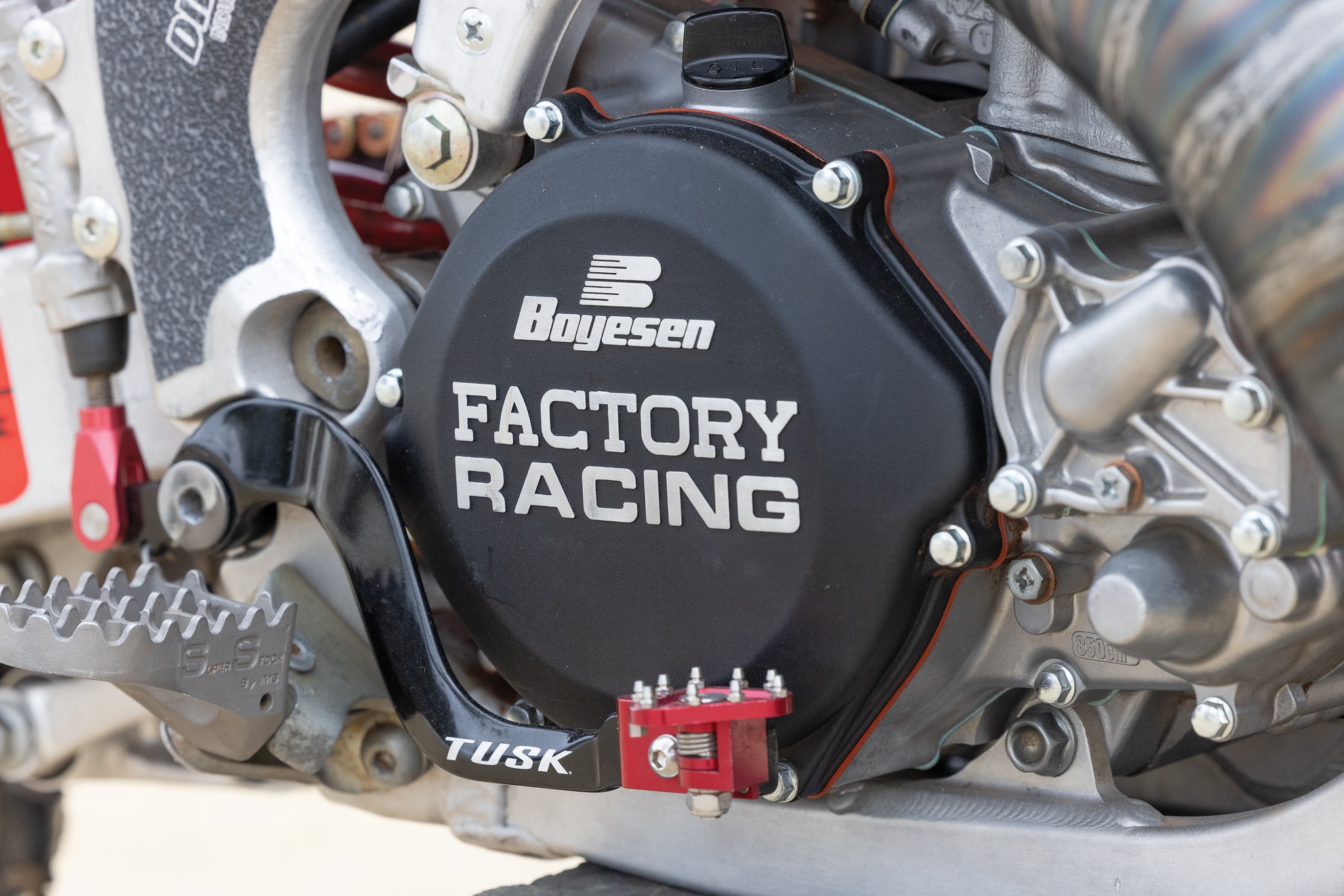 <Boyesen Racing’s clutch cover gave it the factory touch.
<Boyesen Racing’s clutch cover gave it the factory touch.
Along with TMR’s KX315 kit, Robert used Boyesen’s high-flow Supercooler water pump with VForce3 reeds and a Keihin Air Stryker carb. For the intake, Robert used a 2004 KX250 air filter with an adapter plate by Possum Valley Racing and Nub Tools mated to a 2020 KX250 airbox. Of course, Robert went with an FMF Fatty pipe and Turbinecore 2 silencer to finish off the engine.
On the suspension side, Robert called Brian Bolding at N2Dirt in Southern California. Brian set Robert up with a Showa A-Kit spring fork and A-Kit shock with 22mm offset Pro Circuit triple clamps. Faster USA built the wheels with D.I.D STX rims and Dunlop MX33 tires front and rear. Primary Drive supplied the chain and sprockets, and Robert used TM Designworks rear brake guards and chain sliders. For the front brake, Robert used a 2019 KX450 system with a Galfer braided-steel hose and a Tusk rotor. On the rear, he used a 2018 KX250 system with another Galfer braided-steel line and Tusk rotor. At the controls, he had ARC levers, ODI Podium handlebars, ODI Emig Pro lock-on grips, and a Hammerhead shifter and brake pedal with Decal Works tying it all together.
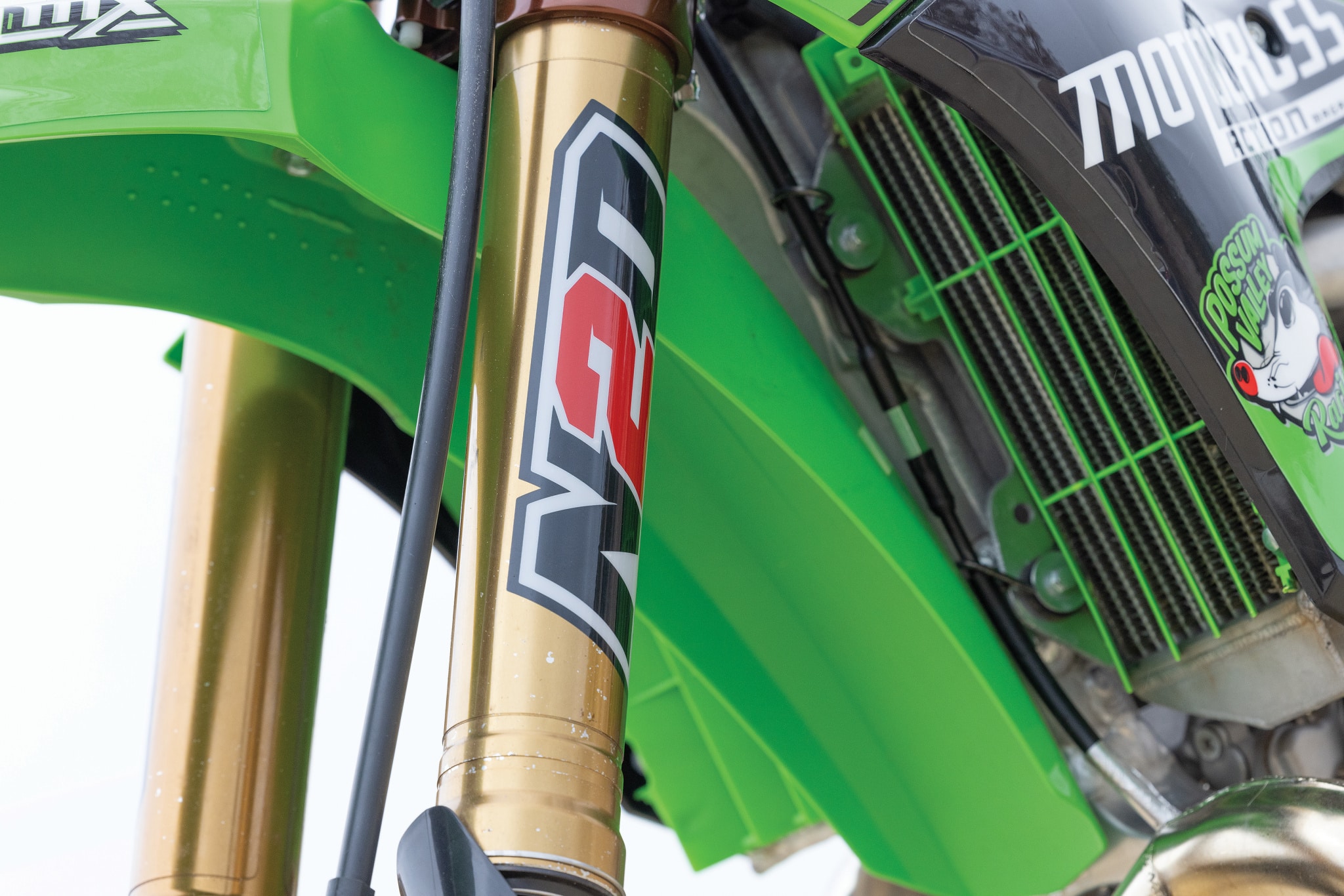 Brian at N2D set up the A-kit Showa suspension.
Brian at N2D set up the A-kit Showa suspension.
This was my first experience on a 315cc, and I had never tested a KX327, either. I was surprised by the pull and over-rev feel; the KX315 engine just kept going. It reminded me a lot of a 500 two-stroke, but even if you didn’t shift, it would keep pulling. I have ridden my fair share of 500cc two-stroke engines that don’t like to be revved. You have to ride 500s a gear high and lug them around the track. This bike still has a rideable feel that you can rev. Most 300cc two-strokes I’ve ridden (carbureted and fuel-injected) have felt like really fast 250 two-strokes. This KX315 felt like a more forgiving KX500. It wasn’t light and snappy like a 250, but it also wasn’t as heavy and gnarly as a 500. It fits into its own little sweet spot.
The bike handled well considering the engine was not made for this chassis. AJ Waggoner has made a career out of shoehorning two-stroke engines into modern-day chassis. He was the man behind the Service Honda CR500s, and he did a great job on Robert’s bike. The Fasst Company footpegs were interesting. Robert chose the Impact Moto footpegs with rubber inserts that isolate the cleats from the footpeg itself to limit vibration, but they also make for a weird wiggle when under a high G-load on the lip of the high-speed tabletop before the velodrome corner. I loved these pegs everywhere else!
There you have it! Three different two-stroke project bikes. Maybe its time you built one for yourself!


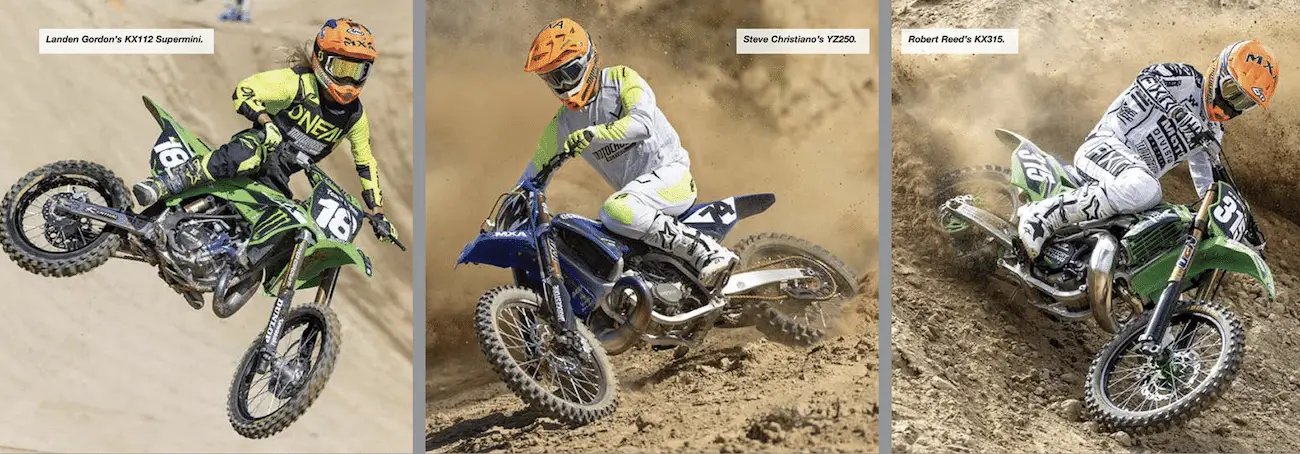





Comments are closed.